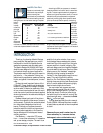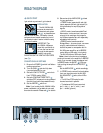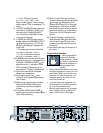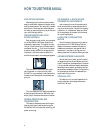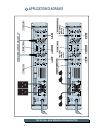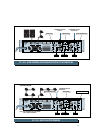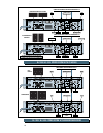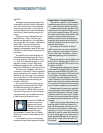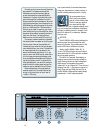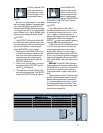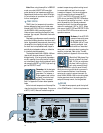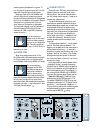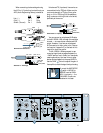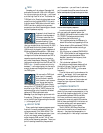
11
FEATURE DESCRIPTIONS
GAIN
These giant knobs control the levels to the
output section of the M•1200/M•1400 amplifi-
ers. You’ll notice that their travel is detented,
meaning there are 40 built-in “resting points”
so you can easily set both controls to the same
level. Usually, these controls are set all the
way up.
The gain structure of the amplifier is de-
signed so that a +4 dBu (1.23V rms) input
signal drives the amplifier to full rated power
into 4 ohms (40V rms @ 4 ohms = 400 watts for
the M•1200). This is how the sensitivity
of an amplifier is defined. In this case, it
equates to a voltage gain of about 30 dB (okay,
30.24 dB for those of you sittin’ there with your
calculator!).
The graphics around the knob depict two
different methods for setting the gain. The in-
ner circle is marked in dB, calibrated from off
(∞) to 30. This represents the amount of volt-
age gain from input to output. When using
professional equipment with +4 dBu output
levels, set the
GAIN
control all the way up to 30.
The outer circle is labeled in volts, with in-
dications of 1V, 2V, and 3V. These correspond to
the input sensitivity of the amplifier. With the
GAIN
control all the way up (fully clockwise),
the input sensitivity is 1.23V, which works well
with professional equipment operating at a
nominal +4 dBu level.
On the other hand, you may want your lis-
tening level to be quieter than the M•1200/
M•1400’s maximum level. For instance, if
you’re using the M•1200/M•1400 as a control
room amp, and your control room is the size of
a telephone booth, you’ll probably never want
to hear the amp at its maximum level.
You can set the
GAIN
con-
trols as low as you like.
However, reducing the
GAIN
controls requires an
increased input level to
reach full power at the amplifier’s output.
See the sidebar “Constant Gain vs. Constant
Sensitivity” for a better understanding of how
this works.
Like all amplifier controls, you’ll typically
determine the optimal settings during installa-
Constant Gain vs. Constant Sensitivity
There are two viewpoints, or philosophies,
regarding the gain structure of power amplifi-
ers — constant gain and constant sensitivity.
Constant gain means that regardless of the
output power of the amplifier, the gain from in-
put to output remains the same. (By the way,
this refers to the full gain of the amplifier, with
the gain or level controls all the way up.)
Within a product line of constant gain power
amplifiers, as the output power rating of an
amplifier increases, the level of the input volt-
age must also increase.
For example, if an amplifier is rated at
100W into an 8-ohm load, and it has 26 dB of
gain, it requires an input signal of 1.4V rms to
drive it to full power. This is about +5 dBu, a
reasonable operating point for professional
gear.
Now take an amplifier rated at 200W into an
8-ohm load. If it also has a gain of 26 dB, it re-
quires an input signal of 2.0V rms to drive it to
full power, or +8 dBu.
This can become problematic as the power
of the amplifier increases. What if you have a
power amp rated at 800W into 8 ohms? This
will require an input signal of 4.0V rms to drive
it to full power. This equates to a whopping
+14.3 dBu!! You’ve just robbed your mixer of
10 dB of headroom. You’ll either have to have a
good limiter to keep the transient peaks down,
or turn down the level from the mixer and not
use all the power available from the amplifier.
Constant sensitivity means that regardless
of the output power of the amplifier, the input
sensitivity of the amplifier (the input voltage
required to attain full output power) remains
the same. As the output power of an amplifier
increases, the gain of the amplifier must also
increase.
Referring back to the previous example, an
amplifier rated at 100W into 8 ohms with a
gain of 26 dB requires an input signal of 1.4V
rms to drive it to full power. It has an input
sensitivity of 1.4V rms. In order for the 200W
amplifier to reach full power into 8 ohms with
a 1.4V rms input signal, it must have a gain of
29 dB. And the 800W amplifier will require a
gain of 35 dB to reach full power with a 1.4V
input signal.
Continued on page 12



